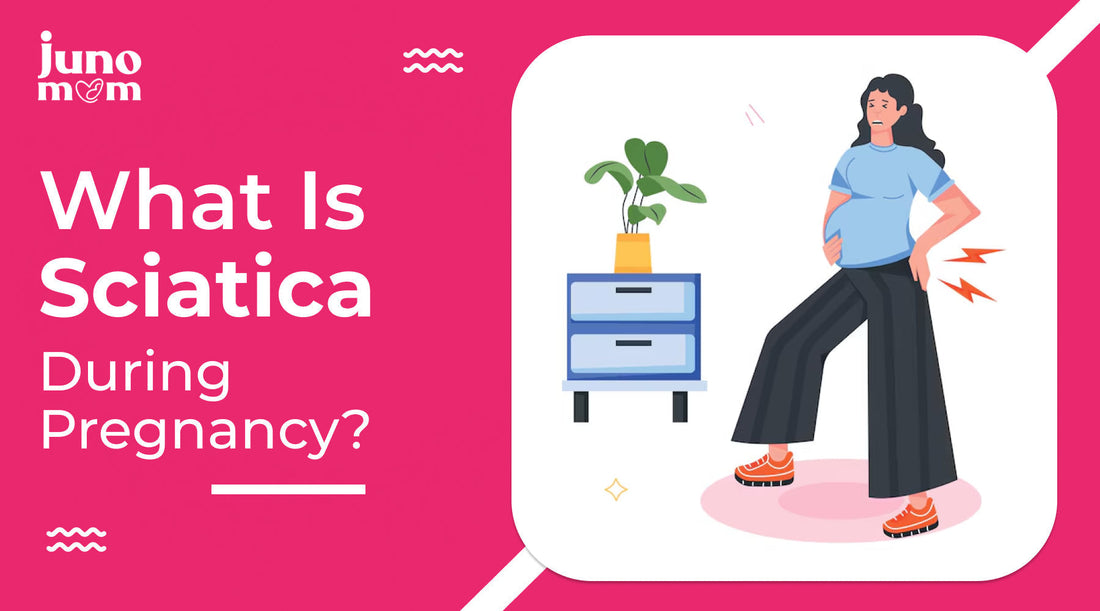Pregnancy is a beautiful journey, but it comes with its fair share of challenges. Usually, first-time parents are not aware of these challenges and sometimes they miss a lot of symptoms as well. When you have an older generation at home, they definitely guide you but there’s always some lack of awareness and information. To help you through your first-time pregnancy journey, and walk you through all the challenges, read with Juno Mom.

One such challenge some women face is sciatica, a type of nerve pain that can occur during pregnancy. Sciatica is caused by irritation or compression of the sciatic nerve, which runs from the lower back through the hips, buttocks, and down each leg. It’s especially common in the third trimester of pregnancy, as the body adjusts to accommodate the growing baby.
Understanding sciatica and knowing how to manage it can make a significant difference in your pregnancy life.
Causes of Sciatica During Pregnancy
Let’s understand some common causes of sciatica during pregnancy:
- Increased Weight and Pressure: As your baby grows, the extra weight puts pressure on your lower back and pelvis, which can compress the sciatic nerve.
- Shifts in Posture: Changes in balance and posture due to the growing belly can strain your back and hips.
- Hormonal Changes: Pregnancy hormones like relaxin loosen the ligaments around your pelvis, which can increase pressure on the nerve.
- Baby’s Position: In some cases, the baby’s position, especially before delivery, can press directly on the sciatic nerve.

These are the things that can lead to consistent pain and discomfort.
Symptoms of Sciatica During Pregnancy
Some people may think it is like normal back and leg pain, but sciatica is different from regular back pain. Some common symptoms which can help you distinction, include:
- Sharp or Shooting Pain: It often radiates from the lower back to the hips and down one leg.
- Numbness or Tingling: You may feel a “pins and needles” sensation in your legs or feet.
- Weakness: Difficulty in standing or walking for long periods.

Is It Sciatica or Normal Back Pain?
While back pain is common during pregnancy, sciatica is more intense and localized. Unlike general back pain, sciatica pain typically follows the path of the sciatic nerve and may be accompanied by tingling or numbness. If you’re unsure, consult your doctor to rule out other conditions.
How to Treat Sciatica Naturally During Pregnancy
Prenatal Stretches and Yoga
-Gentle stretches like the cat-cow pose or pelvic tilts can help ease the pain.
-Yoga poses designed for pregnancy can also relieve tension in your lower back.
Heat and Cold Therapy
-Apply a warm compress to loosen tight muscles.
-Alternate with a cold pack to reduce inflammation.
Improve Your Posture
-Sit on supportive cushions and avoid slouching.
-Use a pregnancy support belt to relieve pressure on your lower back.
Stay Active
-Gentle exercises, like walking or swimming, can improve blood flow and reduce nerve compression.
Sleep Positions
-Use pillows for support and sleep on your side with your knees slightly bent.
Medical Treatments for Sciatica During Pregnancy
While natural remedies are helpful, some cases of sciatica may require medical attention:
- Physical Therapy: A trained therapist can guide you through exercises to strengthen your core and relieve pressure on the sciatic nerve.
- Chiropractic Care: Adjustments by a qualified chiropractor can help align your spine and reduce nerve pain.
You must consult your doctor before starting any new activity plus do not take any medicines without confirmation.
Tips to Prevent Sciatica During Pregnancy
- Maintain a Healthy Weight: Excess weight can increase pressure on the sciatic nerve.
- Avoid Heavy Lifting: Use proper bending techniques if you must lift something.
- Supportive Footwear: Ditch the heels and opt for comfortable shoes with good arch support.
-
Rest Smart: Take breaks throughout the day and avoid prolonged standing or sitting.
If the pain becomes unbearable and your body starts feeling weaker, do not spend a single second and consult your doctor first.
Conclusion
Sciatica during pregnancy is a common yet manageable condition. With the right care, such as stretching, improving posture, and staying active, you can reduce discomfort and continue to enjoy your pregnancy life. Remember, each pregnancy is unique, so don’t hesitate to seek professional advice if needed. Whether it’s natural remedies or medical treatments, addressing sciatica early can make your pre-natal journey more comfortable and stress-free.
By staying informed and proactive, you’ll be better prepared to tackle any challenges during your pregnancy, ensuring a smoother transition to childbirth and beyond.


